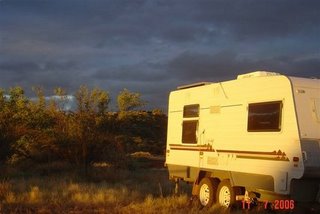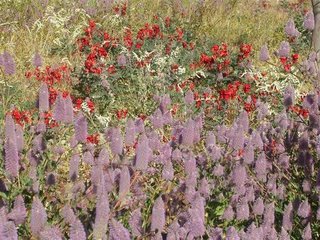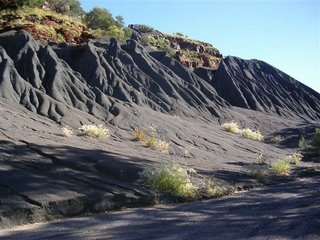
These hills appeared to have been pushed up out of the earth in many folds. As the sun went down we witnessed an incredible sunset which we were unable to capture on camera as calamity struck – after three years George’s overworked digital camera had finally given up the ghost! It is only thanks to Paula, our back-up camera girl, that we have been able to provide photos this week.
During the course of the night a wind came up which had Skiv & Getaway being knocked this way and that as it howled around and temperatures plummeted. In the morning, bleary-eyed, we looked up in dismay at wintery skies and as the day passed we steadily added layers of clothing! By the time we reached Tom Price, the “top town” by virtue of being the highest in Western Australia, we were reluctant to walk the streets as uncertain skies threatened rain and the wind chill was severe. In order to obtain a permit to travel the privately run Pilbara Rail access road George had to watch a video in the Visitors centre of the potential hazards involved before we were able to set off for Karijini National Park. That proved no warmer encircled by the Hamersley Range with savannah land of mygums and spinifex stretching out in all directions over gently undulating red soils. We’d been advised to take the gravel road to Savannah Camp ground if we wanted a less crowded place than the other park camp on the tarred road. Although we found ourselves a beautiful site there we were far too cold to appreciate it – just hankering for a warming stew to keep out the awful cold.
Paula assumed the role as our official weather recorder. Next day she reported it was 2°C at 6.00am. Cold enough for our breath to be condensing as we spoke! Clad in our black lumber-jackets we walked to the Joffre Gorge / Falls. We were most impressed by the way the gorges of Karijini lie hidden in seemingly un-dissected country and suddenly appear out of nowhere. 100m deep chasms of red coloured banded iron formations dropping away into the depths of permanently shaded ravines.
Later we visited the Joffre, the Hancock and the Weano Gorges.

The Oxer lookout provided a superb vantage point from which to look down into the confluence of the three. We descended part of the way into Hancock Gorge stopping where the descent continues by ladder. Although scenically, a very attractive area we could not help being struck by the absence of wildlife – a few tiny lizards, hardly any birds, the pools containing no obvious signs of fish and the surrounding woodlands empty of mammals. Not even a kangaroo in an area which purports to have an extremely diverse fauna.
George braved a shower in one of the corrugated iron cubicles equipped with solar heated water and a canvas bag that one fills and raises overhead (a la Keith & Colleen in Niassa) using ropes on a pulley system. All very well except for the chill afterwards, when the wind came howling in under the walls!
Curiosity got the cats… Wittenoom, a mining town on the other side of the Hamersley Range, was on the news recently when the government cut off its electricity supply. Since 1978 the town-site had gradually been closed down because of exposure to blue asbestos dust in the area was considered to be a serious health risk. Once regarded as “Australia’s greatest mining disaster” with asbestos tailings present in backyards, on roads, the race track and even the airport the majority of the population had already left but a handful of stalwarts had remained. We couldn’t resist a visit.
Strange to enter a ghost town with but 7 people remaining, one of whom, Loraine Thomas, we met in the gem / souvenir shop she runs. They maintain that the current level of airborne asbestos in Wittenoom is lower than in many other parts of the state and are determined to stay. One could not help feeling saddened at the sight of the few remnants left of the little settlement against its magnificent mountainous backdrop. The profusion of wild flowers in the empty town-site, Sturt’s Pea, purple mulla mulla and white kapok in particular, was superb and apparently due to the effects of 7 cyclones this season.

Mulla mulla and sturt peas at Wittenoom
On enquiring where we might be able to camp were given “freedom of Witenoom”! We landed up camping in the back yard of the town’s one and only “guest house” where we paid for the privilege of using the ablutions. There we met “Bob” from Bunbury, a very pleasant but lonely old chatter-box who was camping in an ancient, 23 year old, combi. He has been visiting this shang-ri-la since 1997 and was delighted to take us for a walk along the deserted streets, most of the buildings now flattened; past the old Convent, Doc Holiday’s café, the old fuel station and the site of the caravan park, which was simply bulldozed under ground.
The next morning we drove into the Wittenoom gorge along the old road that serviced the mine. A most beautiful area spoilt only by the mess the mining company had left it in when closed 40 years ago. Totally unacceptable by today’s standards! The tailings dumped on the slopes of the gorge have slid into the river below with the result that the bed of the river comprises little else but asbestos wastes. We are amazed that CALM can turn a blind eye to all this in the middle of the Karijini NP.

Tailings dumped from asbestos mine on side of Wittenoom gorge
As we took the Pilbara / Hamersley railway line access road to Karratha George thought one of the wheel bearings on the caravan had gone! It turned out to be an enormous train coming up behind us with 238 coaches filled with iron ore. Lea counted them as they streamed past George’s nose! 400km on gravel roads have taken a toll. We discovered one of the deep cycle batteries in Getaway had become dislodged and even our fridge had tried jumping its casing due to the corrugations. All problems revealing themselves as part and parcel of having had a good “shake down cruise” and, with Getaway being under warranty, we hope to get these attended to in Karratha.
If you have seen the poppies grow on Flanders fields – perhaps you can imagine the equally stupendous sight of Sturt desert peas spilling forth across the verges of the Pilbara rail access road. Not a sign of vehicles, people, buildings ….. and tired of being shaken we pulled off 100km short of Karratha for the night in the midst of some spinifex covered hills next to our railway line with iron ore trains regularly rumbling by only 50m away.
Today, Sunday- we anxiously made our way into Karratha – checking the fridge every 30 kms to push it back into its wooden cabinet. We were most relieved to be given the last remaining site in the caravan park. Tomorrow we can begin sorting out repairs and exploring the Burrup Peninsula outside Dampier.
No comments:
Post a Comment